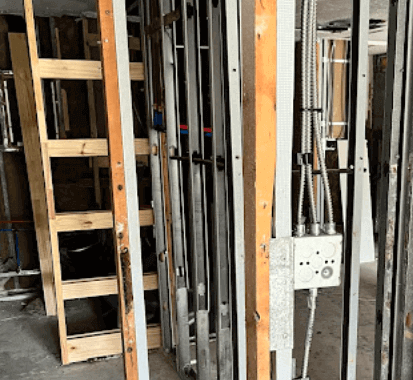What is a furring wall, and why is it crucial in various building applications? Essentially, a furring wall involves attaching thin strips, known as furring strips, to a surface to create a stable, level base for installing finishing materials like drywall or paneling. Understanding what is a furring wall can significantly enhance your project outcomes by providing better insulation, soundproofing, and a smoother surface for your finishes. Read on as we delve into the question: “What is a furring wall?” Explore its multiple uses to understand this vital construction element comprehensively.
Real estate investors Steve Daria and Joleigh have extensively utilized furring walls in their building projects to maximize space efficiency and improve property value. By incorporating furring walls, they achieve superior insulation and soundproofing, enhancing their investments’ overall comfort and appeal. Their adeptness in utilizing this construction method guarantees that their properties distinguish themselves in the fiercely competitive real estate market.
What is a Furring Wall?
What is a furring wall exactly? A furring wall involves attaching strips (furring strips) to an existing fence to create a secondary framework.
This framework serves several purposes, including providing a level surface for finishing materials like drywall or paneling, enhancing insulation, and making space for utilities such as electrical wiring or plumbing.
Furring walls are versatile and commonly used in residential and commercial construction to address uneven surfaces and improve overall wall performance.

Benefits of Furring Walls
Understanding what is a furring wall offer numerous advantages that make them a popular option for many construction projects:
- Improved Insulation: Furring walls enhance thermal insulation by creating an additional layer between the existing fence and the finishing material, improving energy efficiency.
- Soundproofing: The gap created between the furring strips and the original wall helps reduce noise transmission, making rooms quieter and more comfortable.
- Easy Installation: Furring walls are relatively simple, making them accessible for DIY projects or quick renovations.
- Enhanced Aesthetics: They provide a smooth and even surface for applying finishing materials, resulting in a polished look for your interior walls.
Materials for Furring Walls
Choosing the suitable materials for your furring wall depends on durability, moisture resistance, and project specifics.
Here are the most common materials used:
- Wood Furring Strips: Affordable and easy to work with, wood furring strips (often made from pine or cedar) are famous for their versatility in indoor and outdoor applications.
- Metal Furring Channels: Ideal for high-end applications, metal furring channels (typically made from galvanized steel or aluminum) offer exceptional strength and durability.
- Plastic Furring Strips: Lightweight and moisture-resistant plastic furring strips (made from materials like PVC) are perfect for areas where moisture control is essential, such as bathrooms or basements. They are easy to install and maintain.
Get An Offer Today, Sell In A Matter Of Days
How to Install a Furring Wall
Installing a furring wall is a process that can be completed with essential tools and skills. Follow these steps for a successful installation:
Prepare the Existing Wall
Preparing the existing wall is crucial to ensure a smooth and secure installation of furring strips.
Start by completely cleaning the wall surface to remove dust, dirt, and any loose materials that could interfere with the furring strips’ attachment.
Using a scraper or spackle knife to remove old paint or wallpaper, ensuring the wall is free from uneven spots that could affect the strips’ alignment.
Measure and Cut Furring Strips
Accurate measurements ensure the furring strips fit precisely and provide a level surface for finishing materials.
Use a measuring tool to determine the height of the wall and mark where each furring strip will be placed, typically spaced 16 inches apart horizontally.
Double-check measurements to avoid gaps or uneven strip placement.
Attach Furring Strips
Proper attachment of furring strips is essential for stability and support of the finished wall surface.
Begin by positioning each furring strip along the marked lines on the wall, using a level to ensure they are perfectly straight horizontally and vertically.
Secure the furring strips to the existing wall using appropriate screws or nails, ensuring they penetrate the wall studs for maximum strength.
Install Insulation
Insulation can greatly boost the energy efficiency and acoustic performance of your walls.
If you install insulation, measure and cut it to fit snugly between the furring strips.
Position the insulation carefully, ensuring it fills the entire space between each strip without gaps or compression.
Apply Finishing Materials
Once the furring strips and insulation (if used) are in place, it’s time to apply the final finishing materials to achieve your wall’s desired look and functionality.
Depending on your preferences and project goals, you can cover the furring strips with drywall, paneling, or other decorative finishes.
Secure the finishing materials to the furring strips using appropriate fasteners, ensuring a smooth and uniform surface.
Common Applications of Furring Walls
Furring walls can be used effectively in various home improvement projects:
- Basement Renovations: Address uneven concrete walls and improve insulation in basements for enhanced comfort and energy efficiency.
- Attic Conversions: Provide a smooth surface for insulation and finishing materials, transforming attics into usable living spaces.
- Creating Accent Walls: Furring walls can be used to create decorative accent walls using materials like shiplap, beadboard, or reclaimed wood.
Tips for Maintaining Furring Walls
Proper maintenance makes sure the longevity and performance of your furring walls:
- Regular Inspections: Check for signs of moisture, mold, or damage periodically.
- Cleaning and Repainting: Keep the walls clean and repaint as needed to maintain their appearance.
- Monitor Insulation: If insulation is installed, inspect it regularly for damage or wear.

Frequently Asked Questions
Explore the most queries about furring walls to understand further “What is a furring wall?”
What is the Purpose of Furring Strips?
Furring strips create an even surface for attaching finishing materials, improve insulation, and provide space for utilities.
Can Furring Walls Be Used Outdoors?
Yes, furring walls can be used outdoors to create a level surface for siding or other exterior finishes using weather-resistant materials.
How Much Does It Cost to Install a Furring Wall?
Costs vary based on materials and project size, typically from $1 to $3 per square foot.
Conclusion
Understanding what is a furring wall and its advantages is a versatile solution for enhancing your home’s insulation, aesthetics, and functionality. Whether upgrading an attic, renovating a basement, or adding a decorative touch, furring walls offer practical benefits and straightforward installation. Start your project today and discover how furring walls can transform your living spaces with improved comfort and visual appeal.
**NOTICE: Please note that the content presented in this post is intended solely for informational and educational purposes. It should not be construed as legal or financial advice or relied upon as a replacement for consultation with a qualified attorney or CPA. For specific guidance on legal or financial matters, readers are encouraged to seek professional assistance from an attorney, CPA, or other appropriate professional regarding the subject matter.

